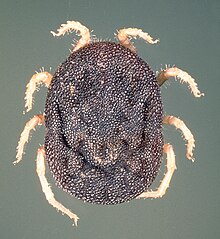Ornithodoros savignyi
| Ornithodoros savignyi | |
|---|---|
 |
|
|
|
|
| Scientific classification | |
| Kingdom: | Animalia |
| Phylum: | Arthropoda |
| Subphylum: | Chelicerata |
| Class: | Arachnida |
| Subclass: | Acari |
| Order: | Ixodida |
| Family: | Argasidae |
| Subfamily: | Ornithodorinae |
| Genus: | Ornithodoros |
| Species: | O. savignyi |
| Binomial name | |
|
Ornithodoros savignyi Audouin, 1827 |
|
| Synonyms | |
|
|
Ornithodoros savignyi aka Sand tampan or African eyed tampan or Kalahari sand tampan, is one of some 37 species in the genus Ornithodoros and is a soft tick with a leathery, mammillated integument, causing paralysis and tampan toxicosis, two unrelated conditions. The sand tampan is an ectoparasite on humans, their livestock and wild animals, including birds and bats. Occurring in semi-desert areas of Africa, Saudi Arabia and other parts of the Persian Gulf, India, Sri Lanka and into Asia, it is able to survive for lengthy periods without feeding, spending most of its life burrowed under sand or loose soil, often in wait for animals that rest or sleep under trees or in the lee of rocks, but also in places where people or their animals congregate such as marketplaces, places of worship, cattle kraals and village squares. The timing of its activity is geared to coincide with that of potential hosts, but hot sunny conditions are usually avoided. Because of its habit of feeding and dropping from its host, adult dispersal is limited, whereas larvae may remain attached to their hosts for several days. During its life cycle it will feed on multiple hosts between moults.
This species is of interest because of the pathogens it carries, and its salivary apyrases which prevent platelet activation and aggregation, that is, blood-clotting. In humans the tick may cause dermatitis, fever and lymphadenitis. It is also a carrier of Borrelia, a spirochaete bacterium, and is a carrier of a flavivirus causing Alkhurma hemorrhagic fever (AHFV). The closely related Kyasanur Forest disease virus (KFDV) is endemic to certain regions of India. That AHFV and KFDV diverged some 700 years ago would suggest that unknown tick-borne hemorrhagic/encephalitic viruses may exist between Saudi Arabia and India.
...
Wikipedia
